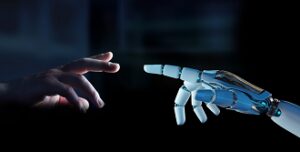
The finality of beings and machines
Edgar Morin says that “we are therefore in the prehistory of finality”, using the Hegelian discourse he will say “the whole ‘itself’ becomes almost a for-itself” (Morin, 1977, p. 242), and so the machine living (to differentiate from artificial ones) from soft cells to the most complex living organisms “are almost specialized in function of quasi-programmed tasks that aim to achieve ends, and all these ends are united in the global end: to live” (idem).
of finality”, using the Hegelian discourse he will say “the whole ‘itself’ becomes almost a for-itself” (Morin, 1977, p. 242), and so the machine living (to differentiate from artificial ones) from soft cells to the most complex living organisms “are almost specialized in function of quasi-programmed tasks that aim to achieve ends, and all these ends are united in the global end: to live” (idem).
It can be said then, in the author’s expression, that “this living being that self-finalizes is the product is the finished product of the reproductive act that originated it” (ibid.), and “retracing” this to the origin of life, the question remains “how is the purpose born of the non-purpose?” (MORIN, 1977, P. 243).
You will then ask what kind of “information” is capable of reproducing and controlling proteins with which they were not yet associated? The idea of information, and therefore of program, and therefore of purpose, cannot be prior to the constitution of a first protocellular ring” (idem), it will conclude from there that “the idea of a final process before the appearance of the life”, perhaps here we separate artificial machines from living beings, its beginning.
He will say in a categorical and essential way that “the biological, and evidently anthropo-sociological, purpose is immersed in a recurrent process of self-generation of which it is a part. It is the immersed and informational face of this generation-of-itself” (ibidem), for those who believe, I say that this is what I think is “God’s image and likeness”, being in an original vital process.
Living and artificial machines will have in common, according to the author, “purposes of the origins of life have repercussions and are reflected in the global purposes of living machines, and even of artificial machines” (MORIN, 1977, p. 243).
It will further differentiate the artificial machine from the live, quoting Paul Valéry: “Artificial means that it tends towards a defined end and, therefore, it opposes live”, for example, the purpose “of a manufacturing is to manufacture cars, whose purpose it is displacement, which serves for constructive activities of the individual’s life in society and of society in the individual” (Morin, 1977, p. 244).
So while the machine has an extrinsic purpose of life, and this purpose should have the intrinsic purpose of biological life, these “complementary purposes can become concurrent and antagonistic, as happens with the purposes of individual existence and reproduction…” (Morin , 1977, p. 245), if they become antagonistic, they can lead to the exclusion of one purpose for the other.
And so, concludes this topic Edgar Morin> “in Homo sapiens, gastronomic pleasures and erotic enjoyments become ends to the detriment of feeding and reproductive purposes; knowledge, a means of surviving in an environment, becomes, in the thinker turned thinker, to which his own existence subordinates” (MORIN, 1977, pp. 245-246).
Thus ends shift, degenerate and become uncertain, like the future of civilization.
MORIN, E. (1977). A natureza da NATUREZA. Lisboa PUBLICAÇÕES EUROPA-AMÉRICA, LDA.









